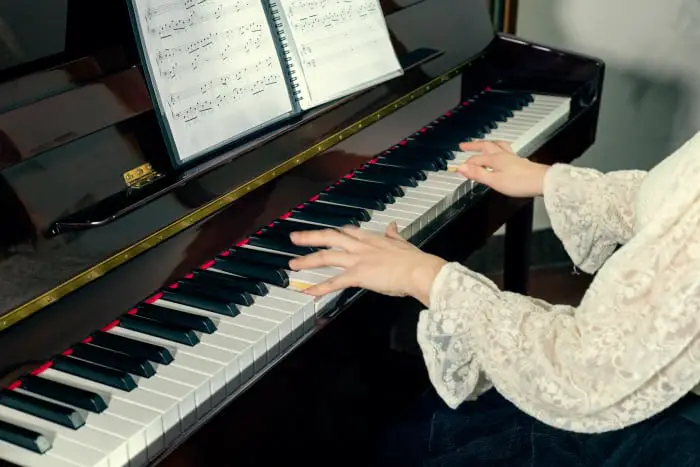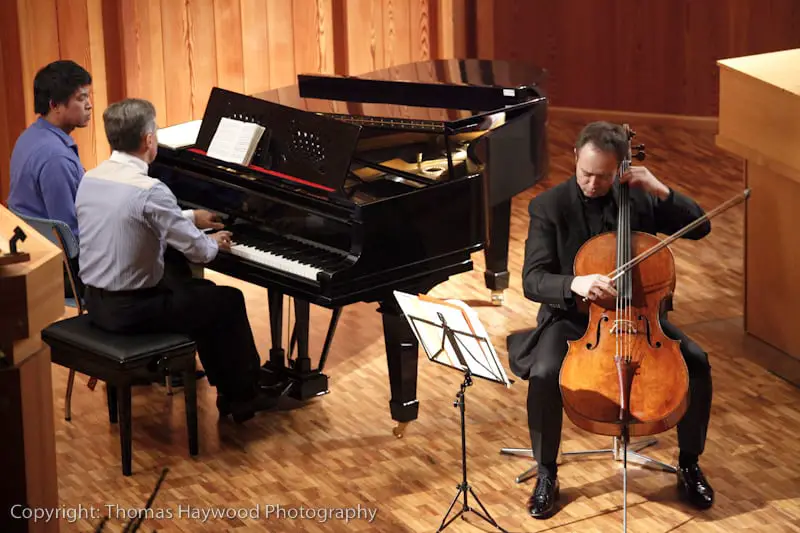If you or your child are considering learning an instrument, a common dilemma is to decide whether to take up the cello or the piano. Which of the two is the harder to learn and play?
The cello is considered harder to learn because of the challenging bowing technique and the fact the cello has no fixed keys to determine pitch. As a fixed-pitch instrument with a keyboard, the piano is easier to learn initially, but later requires complex coordination and musical skills.
Many cellists start their music education with piano lessons. As a result, they started the cello at an older age as the piano. Nevertheless, most of them agree that even though they were older, the cello was still harder.
Table of Contents
Which is harder to learn, cello or piano?
There are a few factors involved in assessing the relative difficulty of learning each instrument initially:
| Aspect | Cello | Piano | Which is harder? |
| Instrument characteristics | Fretless; need to fine-tune strings. | Keyboard; pre-tuned, | Cello |
| Posture | Player posture, cello position, bow holding. | Posture important but not as multifaceted | Cello |
| Setting up | Chair and stand, fine-tuning of strings; tightening of the bow. | Piano fixed and pre-tuned; sit and play. | Cello |
| Playing technique | Two hands completely different movements at once; ear important for pitch. | Two hands similar movements; keys determine pitch. | Cello |
| Lessons | One-on-one lessons essential | Some self-teaching possible | |
| Score reading | One horizontal line of notes; one clef at a time. | Two clefs and up to 10 vertical notes at once. | Piano |
1. Learning piano vs cello: instrument characteristics
Based on the characteristics, the cello is harder to learn than the piano.
The cello, as part of the string family, is fretless. This means it has no keys or marks to indicate precisely where your finger has to be placed on the string to produce a specific note.
It takes time and a lot of practice before your fingers intuitively find the right places. Even then, you have to rely on your ears to determine the correct pitch.
The piano is a stringed, pre-tuned instrument with a keyboard. This means the pianist only has to strike the correct keys on the keyboard to produce the correct and on-pitch notes. In that respect, piano is much easier to play.
2. Learning cello vs piano: posture challenges for a beginner

It is harder to learn the correct posture for cello-playing. Posture on the cello is very important. The beginner cellist has to learn to sit comfortably on a chair with the appropriate height, and to hold the cello correctly.
The cello beginner has to consciously and continuously check his sitting position, the position of the instrument, the right arm angle, and the left hand’s position.
On the piano, posture is also important, but it is not as multifaceted as with the cello. The young pianist only has to adjust the piano stool’s height in such a way that when s/he sits up straight, his/her hands reach the keys with his arms bent at 90 degrees at the elbows.
Although you use body-movement when playing the piano, like bending forward and sideways, the basic seating position stays the same.
3. Learning cello vs piano: setup routine
With everything that has to be done before you start playing, the beginner cellist might be more reluctant to practice, compared to the pianist who can simply sit down and start playing.
Before starting to play a cello, a stand and chair have to be put in place. The bow has to be tightened and the strings have to be tuned to the correct open string pitch.
After a practice, lesson or recital, the process has to be reversed. The bow has to be relaxed again, and the chair and stand are typically put away.
The piano, on the other hand, is a non-portable instrument and is pre-tuned, so you can just sit down and start to play. The only adjustment you might have to make is to get the piano stool the right height. When your practice is over, you just get up and walk away
4. Learning cello vs piano: basic technique
It is harder to learn the basic playing techniques of a cello than the techniques needed for piano playing.
Cello
The new cellist has to learn the basic left-hand fingering for specific harmonics. The ears also have to be consciously taught to determine whether a note is on-pitch.
It’s also hard to master different bow techniques. This requires excellent coordination to use the bow with your right hand while the left hand is finding the right harmonic places on the strings.
It takes time to get used to two hands engaging in completely different types of movement simultaneously.
Cello has a steep learning curve and it takes a fair amount of practice before you can produce a decent sound. You must have a lot of patience to get to the stage where you play your first short melody.
Piano
The initial technique to master on the piano is to place your hands in the correct position on the keyboard and get the fingers and thumbs to work independently.
Both hands also have to play simultaneously. But both hands’ finger actions are similar, and the hands don’t have completely different functions as with the cello.
You have to practice playing single notes and chords on the piano. It takes time to get the fingers “playing-fit” to play notes in quick succession and combination.
The beauty of a keyboard instrument is that you can produce a good and on-pitch sound right from the beginning, even if your technique is still undeveloped.
Although a newbie piano player has to work on finger technique every day, s/he reaches a level where it is possible to perform a small piece of music a lot quicker than the cellist.
5. Cello vs piano: are one-on-one lessons required?
Generally speaking, if you are serious about learning an instrument, you’ll need a teacher.
Learning cello is not a DIY task, you need a teacher to correct your posture and technique issues before they become bad habits.
You can teach yourself to play basic melodies and even some chords. However, if your goal is to develop into a good pianist, you will need some lessons to assist with correct hand position and posture from the beginning, interpretation of the music, and advanced finger techniques.
6. Learning cello vs piano: score reading

This is the one aspect where the new cellist has it easier than the pianist. The cellist starts with one clef and one horizontal line with notes, while the pianist has to read multiple notes vertically from the start.
As the cellist’s skills are developing, s/he will have to learn to read the treble, tenor and bass clefs, however s/he will always need to read just one line of music at a time.
In contrast, from the beginning the pianist has to learn to read the treble and bass clefs. In the piano music score, the notes above middle C are generally written in the treble clef and those below middle C in the bass clef.
Since the pianist commonly plays several notes at once, the skill has to be learned to read up to ten notes vertically on the two clefs at once.
Does knowing piano help in learning cello?
Piano players typically have music theory and sight reading skills that definitely help for learning the cello. Understanding time signatures, key signatures, note values, counting, scales, triads, harmony, and how ensemble music works will come in handy.
Experience with the piano also helps with reading bass clef, and understanding scales and keys help with intonation on the cello, e.g. for chromatic runs. Hand and finger dexterity on the piano can also facilitate learning the cello.
Knowing the piano gives you the background to understand aspects like arpeggio-playing, the role of harmonics, and how to read music.
Musicians who learn the piano first often have the ability to visualize the piano keyboard on the cello frets which helps learning notes.
It’s worth noting, however, than piano players tend to have longer fingers, while people with shorter fingers have an easier time playing string instruments.
***
Photo credits:
Featured image: “ASGW-82-1” (CC BY 2.0) by thaywoodphoto

